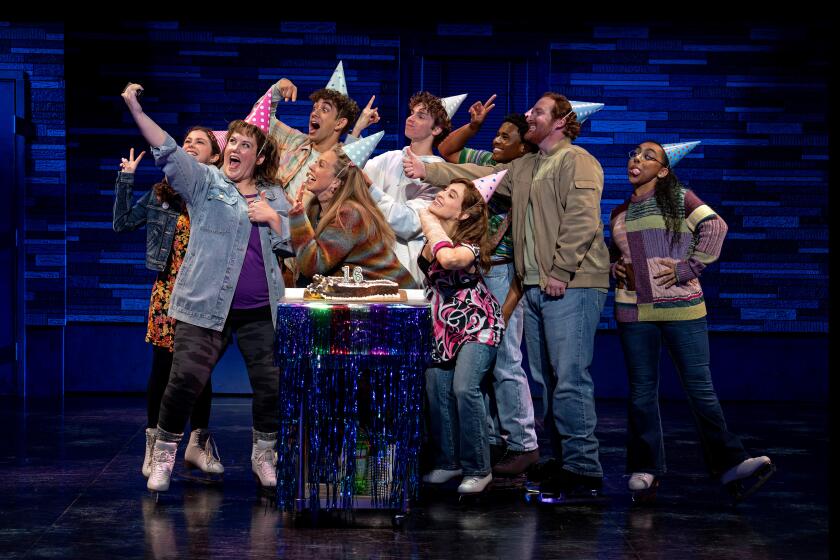ART : Patching Together History : Autry Museum displays works from a quilting contest that inspired thousands of Depression-era women.
January, 1933, was the Depression at its bleakest. Every weekday brought the failure of another bank, and the president who would set the nation on the long, hard road to recovery had been elected, but wouldn’t be inaugurated until March.
Then, for thousands of women, hope arrived in the mail. Sears, Roebuck and Co. announced a contest in its January sales catalogue--a grand prize of $1,000 to go to the country’s “Best Quiltmaker.” Entrants had until May 15 to complete a bed-sized quilt, made with or without the fabric, batting, patterns and other quilt-making supplies readily available from Sears.
Imagine how seductive the prize must have been in a country with too few jobs. In 1933 a new Ford cost less than $500, a three-bedroom house just $3,000. Nobody knows just how many women--or men, for that matter--began sketching ideas, sorting through their fabric scraps and stitching like mad. With only four months until the deadline, the sewing took on the frenzied pace of a marathon, an ordeal by needlework that must have sometimes seemed like “They Shoot Quilters, Don’t They?”
Ultimately, 27,000 quilts were entered--one for every 2,000 women in the United States. More than 20 of the quilts associated with that historic contest--the largest quilt competition ever held--are currently on display at the Autry Museum of Western Heritage in Griffith Park.
The contest was conceived as part of the 1933 Chicago World’s Fair, which celebrated “A Century of Progress” in the 100-year-old city where Sears has its headquarters. Called “Patchwork Souvenirs: Quilts from the 1933 Chicago World’s Fair,” the exhibit includes memorabilia from the Chicago exposition. Originally organized by the Knoxville Museum of Art in 1993, the show will remain at the Autry through Sept. 10, when it will travel to venues in Wisconsin, Kentucky and Tennessee. It has already been seen at museums and historical societies in Massachusetts, Florida, Michigan, Illinois and Kansas.
The show was put together by Merikay Waldvogel and Barbara Brackman, independent scholars who view the quilts, many of which feature non-traditional motifs associated with Chicago and the fair, as windows on the Depression and the lives of women who used their needles to make both money and works of art.
To find quilts for the show and to write “Patchwork Souvenirs of the 1933 World’s Fair” (Rutledge Hill Press), their book about the Sears quilts, Waldvogel and Brackman became amateur sleuths. As Waldvogel explains, Sears had lost most of its archival material relating to the contest. But she and Brackman are “both frustrated Nancy Drews” who went to work at once on the list of the 30 top finishers that ran in the Sears catalogue for spring, 1934. (They continue to seek information on any quilts and quilters associated with the contest and the 1933 World’s Fair.)
Waldvogel recalls that she and Brackman were in Louisville, Ky., at a meeting of historians, when they found the quilt that took third prize in the Chicago regional competition. Knowing only that the Louisville winner was named Mrs. Frances Klemenz, they went first to the library, Waldvogel reports, “to do the microfilm routine.” Nothing significant turned up. Then Waldvogel had an inspiration. “That’s an unusual name,” she said to her partner. “Let’s look in the phone book.” Only one Klemenz was listed, and he turned out to be the late Frances Klemenz’s brother (she died in 1987). The sought-after quilt, he reported, had been given to Klemenz’s niece, Susan W. Smith.
As Waldvogel explains, present-day owners of contest quilts are often put off by strangers who want to know everything about those family heirlooms, including whether they can photograph the quilts or, worse, borrow them for several years for a traveling show. “Once you find the person,” Waldvogel says, “you have to convince them you’re honest and ethical and explain why you’re ecstatic about these things.”
Mrs. Klemenz’s niece needed considerable convincing. “We sat in her living room for 45 minutes before she asked us if we wanted to see the quilt,” the scholar recalls. Klemenz’s prize-winner, which is in the Autry show, is one of the Waldvogel’s favorites. An original design, it features baskets of flowers, including pendant bleeding hearts, on a soft pink background. When Sears published a modified pattern for the quilt, it characterized the design as “elaborate but not difficult.”
In collecting stories about the quilts and their creators, the researchers heard of winner after winner who sewed long into the night to get her entry done in time. Klemenz, who had lost her job as a seamstress, worked 15 hours a day and finished the quilt with a week to spare. But the stories reveal much more than heroic needlework. Quilt researchers, Waldvogel says, “hear the dirt, too.” Klemenz, for instance, stitched better than she married. As Waldvogel says: “For such a nice person, she kept ending up with these men--I think she married twice--who didn’t treat her very well.”
There is no question, however, about the biggest scandal associated with the contest. Margaret Rogers Caden, the woman lauded by the Sears panel of judges as America’s “Greatest Quiltmaker,” didn’t sew a stitch of her grand-prize winner. Yes, Caden, who helped run her family’s fine sewing business in Lexington, Ky., signed the official Sears form certifying that “this quilt is entirely of my own making.” But as one Lexington quilter observed: “Margaret Caden did not know which end of a needle to thread.”
Instead, Caden had the work on her Unknown Star quilt farmed out to at least three other women, who frantically pieced and sewed against the clock. The extraordinary quality of the entry’s trapunto or stuffed quilting, executed at 16 perfect stitches to the inch, was the element that bowled over the judges. And it was done, not by Caden, but by Mattie Clark Black, a dirt-poor rural seamstress who earned a few dollars for her stunning work.
Caden became a quilting celebrity as a result of her dishonesty--and her impeccable taste in subcontractors. Her “Quilt of the Century” was presented to First Lady Eleanor Roosevelt. Caden, who never publicly owned up to her trickery, shared neither the glory nor the prize money, although she was a rich woman by Depression standards. She even had an elevator in her house. None of the unsung quilters complained to either Sears or Caden, although two kept evidence of their contributions to the famous quilt in the form of scraps. The original quilt disappeared, but a duplicate of what Caden later dubbed the Star of the Bluegrass is on exhibit at the Autry. So are the incriminating scraps.
According to Brackman, the archivist at Sears didn’t know the ugly little story behind the “Quilt of the Century” until she learned it from Waldvogel and Brackman. “That’s why we don’t have contests any more,” the archivist told the researchers.
The 1933 contest promised a $200 bonus to the first-prize winner if her (or his) quilt was an original design on the fair’s Century of Progress theme. But when the judges got down to choosing the national winners from among the regional best, they uniformly chose traditional designs such as the Louisiana Rose and the grand-prize winner itself. Only two Century-of-Progress quilts even made it into the top 30.
*
But the surviving one-of-a-kind quilts appeal the most to contemporary taste. And it is these personal, even idiosyncratic pieces that best illustrate the creativity of ordinary people doing traditional “women’s work” in hard times. The World’s Fair quilts, as these original textiles are often called, are now highly prized. Brackman has none in her collection of about 60 quilts. Their value has surged since she and Waldvogel published their book, and now, Brackman says, she can’t afford one.
A World’s Fair quilt from the Autry’s collection, probably made in Oklahoma, is among those on display, according to local curator Theresa Alanis.
Some of the makers of Century-of-Progress quilts were as original as their designs. Thelma Burleigh Johnston, whose Scenes from Early America quilt features a cloth rendering of Chicago’s historic Fort Dearborn, was a pioneering aviator. No Century-of-Progress quilt is more striking than the Spectrum, an expertly stitched swirl of colors by Edith Morrow Matthews, who died in 1967. Her quilt, made in Winnemucca, Nev., was named best of the 1,000 entries in the Los Angeles regional contest. Matthews used her $210 prize money to support herself and her invalid husband. In Winnemucca, Waldvogel and Brackman report, she was known as the Bobcat Lady because she liked to walk her pet bobcat on a leash.
(BEGIN TEXT OF INFOBOX / INFOGRAPHIC)
WHERE AND WHEN
What: Exhibit: “Patchwork Souvenirs of the 1933 Chicago World’s Fair” at the Autry Museum of Western Heritage.
Location: 4700 Western Heritage Way, across from the Los Angeles Zoo, Griffith Park.
Hours: 10 a.m. to 5 p.m., Tuesday through Sunday, through Sept. 10.
Price: $7.50 for adults, $5 for seniors and students with I.D., $3 for children 2 through 12.
Call: (213) 667-2000.
More to Read
The biggest entertainment stories
Get our big stories about Hollywood, film, television, music, arts, culture and more right in your inbox as soon as they publish.
You may occasionally receive promotional content from the Los Angeles Times.










